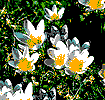










 Corfu's climate is mediterranean and mild. The winter is mild, as the temperature never drops very low, even in January. It rarely snows, while rainstorms are more frequent. The summer is cool and the temperature never exceeds 39o C even on the hottest days. The island has significant percentages of humidity due to southeasterly winds and frequent rain, a phenomenon common to all the Ionian islands as they are situated west of the mountainous zone of Greece.
Corfu's climate is mediterranean and mild. The winter is mild, as the temperature never drops very low, even in January. It rarely snows, while rainstorms are more frequent. The summer is cool and the temperature never exceeds 39o C even on the hottest days. The island has significant percentages of humidity due to southeasterly winds and frequent rain, a phenomenon common to all the Ionian islands as they are situated west of the mountainous zone of Greece.

 The frequent rain and the mild climate of Corfu favour its cultivation. The plains are located along the island's beaches and between the mountain rages, the most significant being the one surrounding the town of Lefkimi.
On the plains, one can find olive groves and fruit trees. The olives have been cultivated ever since the Venetian Rule and today the olive groves cover 40% of the island's surface area, while they occupy more than 70%, of the agricultural population. This fact is central to the island's economy, which is based on single-agriculture. Corfu's grape-vines produce excellent wine. Corfu also has garden products and cereals.
The frequent rain and the mild climate of Corfu favour its cultivation. The plains are located along the island's beaches and between the mountain rages, the most significant being the one surrounding the town of Lefkimi.
On the plains, one can find olive groves and fruit trees. The olives have been cultivated ever since the Venetian Rule and today the olive groves cover 40% of the island's surface area, while they occupy more than 70%, of the agricultural population. This fact is central to the island's economy, which is based on single-agriculture. Corfu's grape-vines produce excellent wine. Corfu also has garden products and cereals.

 Corfu is the most western part of Greece. It is situated in the northern Ionian Sea, 2.5 km away from the Albanian coast. It is the second largest Ionian island, with a surface area of 592 square km and a population of 97,000 inhabitants. The island is 60 km long and 4-30 km wide. The beautiful lace-like coasts are 217 km long. The prefecture of Corfu also includes the islets of Paxi, Antipaxi, Mathraki, Othoni, Erikoussa and others. The prefecture's capital is the town of Kerkira, on the eastern part of the island of Corfu.
Corfu is the most western part of Greece. It is situated in the northern Ionian Sea, 2.5 km away from the Albanian coast. It is the second largest Ionian island, with a surface area of 592 square km and a population of 97,000 inhabitants. The island is 60 km long and 4-30 km wide. The beautiful lace-like coasts are 217 km long. The prefecture of Corfu also includes the islets of Paxi, Antipaxi, Mathraki, Othoni, Erikoussa and others. The prefecture's capital is the town of Kerkira, on the eastern part of the island of Corfu.

 Due to frequent rains, the island of Corfu has dense vegetation. The island's northern part is mainly mountainous, the central part is green with small valleys and the southern part has some vegetation and plains which are cultivated. The wide range to flora, combined with the frequent change of scenery, creates a unique beauty in Corfu.
Due to frequent rains, the island of Corfu has dense vegetation. The island's northern part is mainly mountainous, the central part is green with small valleys and the southern part has some vegetation and plains which are cultivated. The wide range to flora, combined with the frequent change of scenery, creates a unique beauty in Corfu.

 It is said that in pre-historic times the island of Corfu was joined with the Greek mainland and the coast of Albania. A series of earthquakes and avalanches caused a crevice, separating the island from Greece and Albania. Corfu belongs to the Adriatic-Ionian zone and the rock fortifications are sediments and limestone. As with all the Ionians islands, Corfu suffers from frequent earthquakes which are very destructive.
It is said that in pre-historic times the island of Corfu was joined with the Greek mainland and the coast of Albania. A series of earthquakes and avalanches caused a crevice, separating the island from Greece and Albania. Corfu belongs to the Adriatic-Ionian zone and the rock fortifications are sediments and limestone. As with all the Ionians islands, Corfu suffers from frequent earthquakes which are very destructive.

 Corfu has two mountain ranges dividing the island into three parts. Between these rages, there are plains and small valleys. On the island's northern part is mount Pandokrator, the biggest on the island (906 m. high) and the peaks of Arakli (506 m. high), Stravoskiadi (849 m.), Vigla (782 m.) and Tsouka (619m. high). The central part of the island includes the peaks of Agioi Deka (580 m.), Stavros (450 m.) and Agios Mathaios. The southern part is dominated by a lower range ending at Cape Lefkimi, its highest peak being "Hlomos". In ancient times, the island's mountains were covered with forests which currently exist only in the north and do not influence the island's economy.
Corfu has two mountain ranges dividing the island into three parts. Between these rages, there are plains and small valleys. On the island's northern part is mount Pandokrator, the biggest on the island (906 m. high) and the peaks of Arakli (506 m. high), Stravoskiadi (849 m.), Vigla (782 m.) and Tsouka (619m. high). The central part of the island includes the peaks of Agioi Deka (580 m.), Stavros (450 m.) and Agios Mathaios. The southern part is dominated by a lower range ending at Cape Lefkimi, its highest peak being "Hlomos". In ancient times, the island's mountains were covered with forests which currently exist only in the north and do not influence the island's economy.

 The people of Corfu are happy and easy to get along with. Because of their turbulent history, they are used to living with people from various cultures with varying customs, thus they are kind and hospitable to foreigners. The people of Corfu love music and dancing and they are always very cheerful. A testament to their liveliness is evident in their musical voices and their gestures.
Nevertheless, the recent touristic development of the island has affected their character, causing them to become more intense and cosmopolitan.
The people of Corfu are happy and easy to get along with. Because of their turbulent history, they are used to living with people from various cultures with varying customs, thus they are kind and hospitable to foreigners. The people of Corfu love music and dancing and they are always very cheerful. A testament to their liveliness is evident in their musical voices and their gestures.
Nevertheless, the recent touristic development of the island has affected their character, causing them to become more intense and cosmopolitan.
http://www.areianet.gr/infoxenios/
